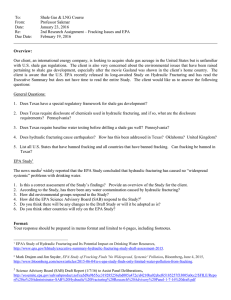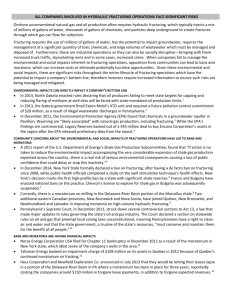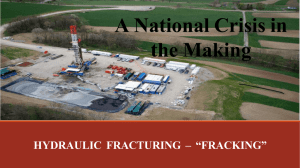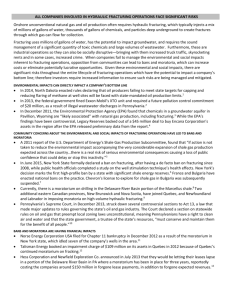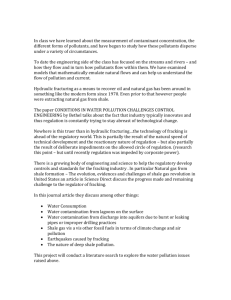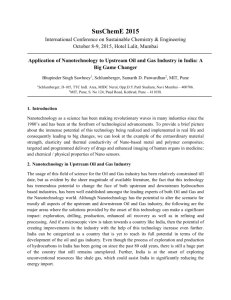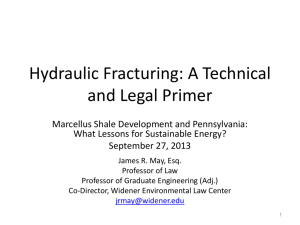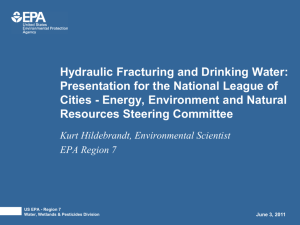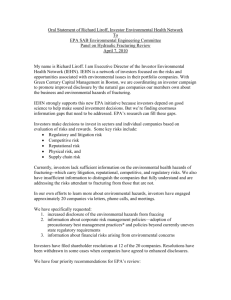all companies invoved in hydraulic fracturing operations face
advertisement
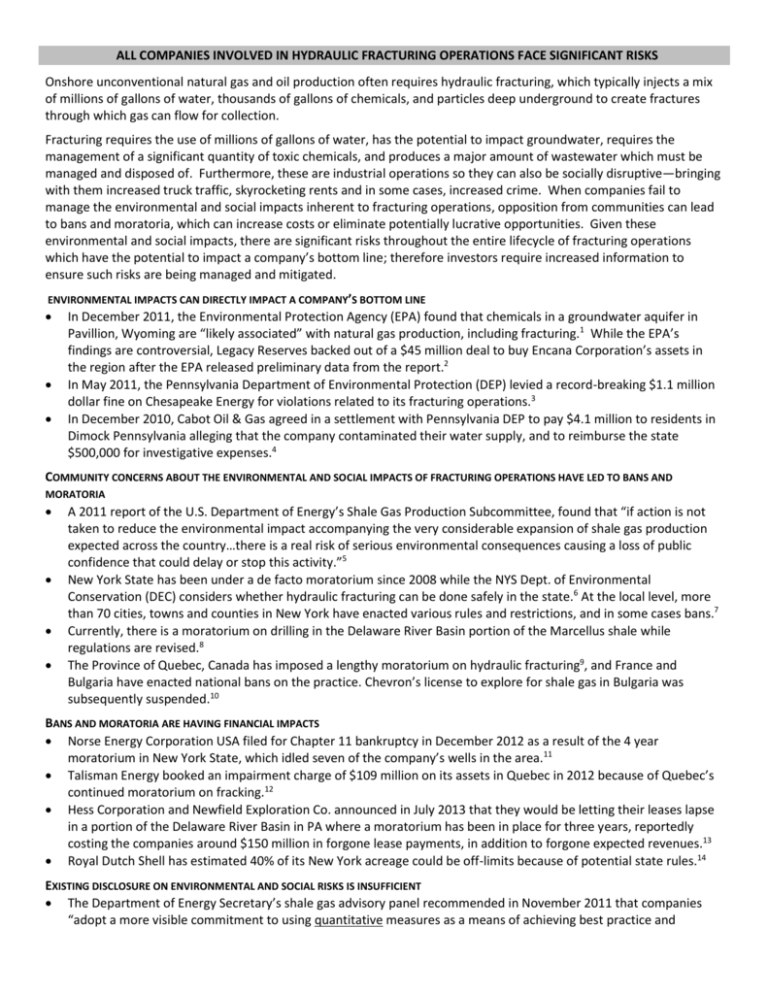
ALL COMPANIES INVOLVED IN HYDRAULIC FRACTURING OPERATIONS FACE SIGNIFICANT RISKS Onshore unconventional natural gas and oil production often requires hydraulic fracturing, which typically injects a mix of millions of gallons of water, thousands of gallons of chemicals, and particles deep underground to create fractures through which gas can flow for collection. Fracturing requires the use of millions of gallons of water, has the potential to impact groundwater, requires the management of a significant quantity of toxic chemicals, and produces a major amount of wastewater which must be managed and disposed of. Furthermore, these are industrial operations so they can also be socially disruptive—bringing with them increased truck traffic, skyrocketing rents and in some cases, increased crime. When companies fail to manage the environmental and social impacts inherent to fracturing operations, opposition from communities can lead to bans and moratoria, which can increase costs or eliminate potentially lucrative opportunities. Given these environmental and social impacts, there are significant risks throughout the entire lifecycle of fracturing operations which have the potential to impact a company’s bottom line; therefore investors require increased information to ensure such risks are being managed and mitigated. ENVIRONMENTAL IMPACTS CAN DIRECTLY IMPACT A COMPANY’S BOTTOM LINE In December 2011, the Environmental Protection Agency (EPA) found that chemicals in a groundwater aquifer in Pavillion, Wyoming are “likely associated” with natural gas production, including fracturing.1 While the EPA’s findings are controversial, Legacy Reserves backed out of a $45 million deal to buy Encana Corporation’s assets in the region after the EPA released preliminary data from the report.2 In May 2011, the Pennsylvania Department of Environmental Protection (DEP) levied a record-breaking $1.1 million dollar fine on Chesapeake Energy for violations related to its fracturing operations.3 In December 2010, Cabot Oil & Gas agreed in a settlement with Pennsylvania DEP to pay $4.1 million to residents in Dimock Pennsylvania alleging that the company contaminated their water supply, and to reimburse the state $500,000 for investigative expenses.4 COMMUNITY CONCERNS ABOUT THE ENVIRONMENTAL AND SOCIAL IMPACTS OF FRACTURING OPERATIONS HAVE LED TO BANS AND MORATORIA A 2011 report of the U.S. Department of Energy’s Shale Gas Production Subcommittee, found that “if action is not taken to reduce the environmental impact accompanying the very considerable expansion of shale gas production expected across the country…there is a real risk of serious environmental consequences causing a loss of public confidence that could delay or stop this activity.”5 New York State has been under a de facto moratorium since 2008 while the NYS Dept. of Environmental Conservation (DEC) considers whether hydraulic fracturing can be done safely in the state.6 At the local level, more than 70 cities, towns and counties in New York have enacted various rules and restrictions, and in some cases bans.7 Currently, there is a moratorium on drilling in the Delaware River Basin portion of the Marcellus shale while regulations are revised.8 The Province of Quebec, Canada has imposed a lengthy moratorium on hydraulic fracturing9, and France and Bulgaria have enacted national bans on the practice. Chevron’s license to explore for shale gas in Bulgaria was subsequently suspended.10 BANS AND MORATORIA ARE HAVING FINANCIAL IMPACTS Norse Energy Corporation USA filed for Chapter 11 bankruptcy in December 2012 as a result of the 4 year moratorium in New York State, which idled seven of the company’s wells in the area.11 Talisman Energy booked an impairment charge of $109 million on its assets in Quebec in 2012 because of Quebec’s continued moratorium on fracking.12 Hess Corporation and Newfield Exploration Co. announced in July 2013 that they would be letting their leases lapse in a portion of the Delaware River Basin in PA where a moratorium has been in place for three years, reportedly costing the companies around $150 million in forgone lease payments, in addition to forgone expected revenues.13 Royal Dutch Shell has estimated 40% of its New York acreage could be off-limits because of potential state rules.14 EXISTING DISCLOSURE ON ENVIRONMENTAL AND SOCIAL RISKS IS INSUFFICIENT The Department of Energy Secretary’s shale gas advisory panel recommended in November 2011 that companies “adopt a more visible commitment to using quantitative measures as a means of achieving best practice and demonstrating to the public that there is continuous improvement in reducing the environmental impact of shale gas production”.15 The International Energy Agency (IEA), in its 2012 report, “Golden Rules for a Golden Age of Gas” addressed the need of the energy industry to maintain or earn its social license to operate, stating that “full transparency, measuring and monitoring of environmental impacts and engagement with local communities are critical to addressing public concerns.”16 IEA continued, “Operators need to explain openly and honestly their production practices, the environmental, safety, and health risks and how they are addressed.”17 In 2011, the Investor Environmental Health Network and the Interfaith Center on Corporate Responsibility published “Extracting the Facts: An Investor Guide to Disclosing Risks from Hydraulic Fracturing Operations” to provide a framework for companies to improve disclosure.18 These guidelines have earned support from investors on three continents managing assets more than $1.3 trillion, as well as from companies—Apache, Southwestern, Talisman,— and environmental organizations—Environmental Defense Fund and the Natural Resources Defense Council. Despite widespread recognition regarding the importance of disclosure, a recently released scorecard report found industry-wide failure in meeting investor needs for disclosure of operational impacts and mitigation efforts associated with hydraulic fracturing operations. The 2013 report ‘Disclosing the Facts: Transparency and Risk in Hydraulic Fracturing Operations’, reported that none of the 24 companies assessed provided sufficient disclosure on even half of the selected 32 indicators related to management of toxic chemicals, water and waste, air emissions, community impacts, and governance.19 SHAREHOLDERS LACK THE INFORMATION NEEDED TO FULLY ASSESS RISK TO THE SECTOR AND DIFFERENTIATE AMONG INDIVIDUAL COMPANIES Investment value may be undermined by company decision-making and policies that lag public and regulatory expectations for environmental protection. In the absence of meaningful disclosure, investors cannot differentiate risks and rewards at various companies. It is necessary for investors to have assurance that company managers are reducing business risks by addressing operational hazards and are capturing the genuine, measurable business rewards flowing from environmental management practices that have the potential to lower costs, increase profits and enhance community acceptance. Investors require relevant, reliable, and comparable information about companies’ natural gas operations to make investment judgments based on a robust assessment of companies’ environmental, social, and governance policies, practices and performance. For further information: Richard Liroff, Investor Environmental Health Network, rliroff@iehn.org (Updated January 2014) “EPA Releases Draft Findings of Pavillion, Wyoming Ground Water Investigation for Public Comment and Independent Scientific Review” http://yosemite.epa.gov/opa/admpress.nsf/20ed1dfa1751192c8525735900400c30/ef35bd26a80d6ce3852579600065c94e!OpenDocument 2 “Tainted-Well Lawsuits Mount Against Frackers Led by Cabot,” http://www.bloomberg.com/news/2012-01-31/tainted-well-lawsuits-mount-against-gas-frackers-ledby-cabot.html; “Company Backs Out of Deal to Buy Controversial Wyoming Assets,” http://www.platts.com/RSSFeedDetailedNews/RSSFeed/NaturalGas/6718143 “EPA Ties Fracking, Pollution,” http://online.wsj.com/article/SB10001424052970203501304577086472373346232.html “Texas firm to buy controversial natural gas assets in Wyoming” http://trib.com/news/state-and-regional/texas-firm-to-buy-controversial-natural-gas-assets-in-wyoming/article_fef7bf75-4680-509c-a17b7231caeb7855.html 3 “DEP Fines Chesapeake Energy More than $1 Million”, http://www.portal.state.pa.us/portal/server.pt/community/newsroom/14287?id=17405&typeid=1 4 “Driller Settles with Pa. over contaminated water wells”, http://www.post-gazette.com/pg/10350/1111252-100.stm 5 “Shale Gas Production Subcommittee Second Ninety Day Report,” http://www.shalegas.energy.gov/resources/111811_final_report.pdf 6 “High Volume Hydraulic Fracturing Proposed Regulations” http://www.dec.ny.gov/regulations/77353.html 7 “As Gas Drilling Spreads, Towns Stand Ground Over Control,” http://www.nytimes.com/2011/12/15/us/towns-fighting-to-stand-ground-against-gasdrillers.html?pagewanted=all 8 “DRBC Postpones November 21 Meeting On Drilling Rules, No New Date Set” http://www.paenvironmentdigest.com/newsletter/default.asp?NewsletterArticleID=20779&SubjectID 9 “Talisman Suspends Shale Gas Exploration in Quebec” http://www.theglobeandmail.com/globe-investor/talisman-suspends-shale-gas-exploration-inquebec/article4753334/ 10 “Bulgaria Bans Gas Fracking, Thwarting Chevron Drilling Plan”, http://www.businessweek.com/news/2012-01-19/bulgaria-bans-gas-fracking-thwarting-chevrondrilling-plan.html 11 “Norse Energy's U.S. Unit Files for Chapter 11” http://online.wsj.com/article/SB10001424127887323501404578165540473583564.html 12 “Talisman Suspends Shale Gas Exploration in Quebec” http://www.theglobeandmail.com/globe-investor/talisman-suspends-shale-gas-exploration-inquebec/article4753334/ 13 “Hess Corporation, Newfield Exploration Co. Leave Pennsylvania Due to Fracking Moratorium”. http://www.huffingtonpost.com/2013/07/16/hess-corporationnewfield-exploration-co-pennsylvania-fracking_n_3604598.html 14 “Insight: N.Y. Gas Drillers' Victory Soured by Tough New Rules” http://www.reuters.com/article/2011/10/21/us-newyork-shale-idUSTRE79K4YT20111021 15 “Shale Gas Production Subcommittee Second Ninety Day Report” http://www.shalegas.energy.gov/resources/111811_final_report.pdf 16 http://www.worldenergyoutlook.org/media/weowebsite/2012/goldenrules/WEO2012_GoldenRulesReport.pdf , page 9 17 IEA Golden Rules Report, page 43 18 http://www.iehn.org/documents/frackguidance.pdf 19 www.disclosingthefacts.org 1
